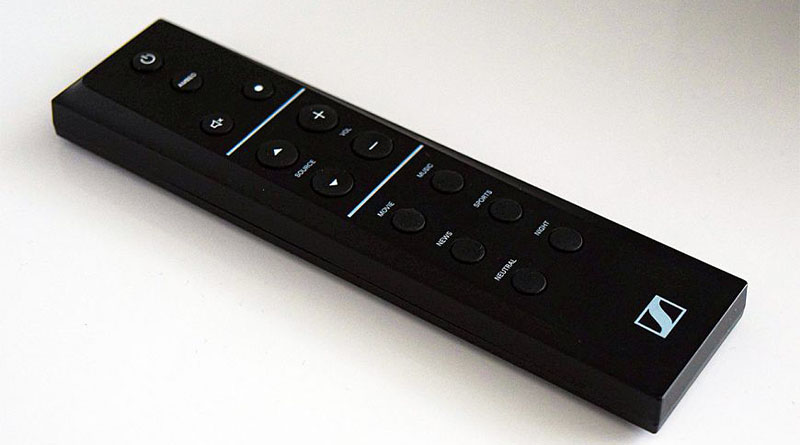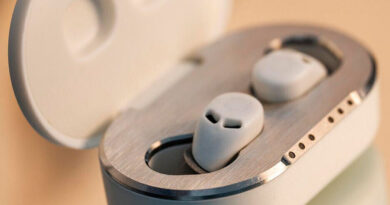Sennheiser AMBEO Soundbar Review
We have already been introduced to the Sennheiser AMBEO soundbar many times at exhibitions and presentations, but only now we have the opportunity to spend a whole day in the company of this – and this is not an exaggeration-unique device, which has become a new page of development for the German company.
The soundbar segment has become the fastest growing in the home theater market in recent years, but there are not so many truly breakthrough models on it. Not all manufacturers have the ability and desire to create powerful soundbars rich in original solutions that could completely replace a home theater component system.

Yes, the progress in the sound quality of sound panels is impressive – the correct alignment of the amplifiers and the emitters used allows you to give these compact devices a sound that is very close to that of a real home theater. However, to take the last small step and finally erase the line between a full-fledged home theater, prevent the inexorable laws of physics, which have not yet been able to overcome anyone. Or did it succeed?
Contents:
Design, Features

Since its presentation in 2019, the Sennheiser AMBEO Soundbar has become the envy of competitors and a cause for confusion on the part of specialists – did the company’s developers still manage to overcome the limitations of the form factor and get a soundbar that can convincingly deceive the feelings of the listener to such an extent that he will not feel the lack of saturation of the sound picture behind his back? The EISA 2019-2020 award received by the model in the “Premium Soundbar” category, although it indicates the non-standard status of the model, it still does not guarantee a technical breakthrough. Therefore, we will understand.

Let’s start with the construction. Inside the oblong metal and plastic housing, 13 emitters are installed, organized in the 5.1.4 configuration. The set includes six woofer drivers with four-inch cellulose diffusers, five-inch tweeters with aluminum domes, and two 3.5-inch broadband emitters. The last two are placed on the edges of the top panel of the soundbar and are directed upwards, and two of the five tweeters are mounted on the side walls. All six bass speakers are pointed forward, with four of them solely responsible for reproducing low-frequency effects. The total power of all soundbar amplifier modules operating in Class D is 500 Watts at peak.

The set of physical inputs in the model is exhaustive – three HDMI 2.0 a ports, one HDMI 2.1 eARC port, an Ethernet network connector, an optical digital input, an analog stereo input on RCA, there is also a 2.5 mm jack for a calibration microphone. The wireless capabilities of the soundbar are also on top – in addition to the mandatory Bluetooth, there is also Wi-Fi, there is built-in support for Google Chromecast and UPnP client. A separate RCA output is provided for connecting an external active subwoofer.

The Sennheiser AMBEO Soundbar processor supports all kinds of ambient sound formats, including Dolby Atmos, DTS:X and even such rare ones as Sony 360 Reality Audio and MPEG-H. The model is also capable of reproducing the DSD stream over the network. The dimensions of the soundbar are 1265 x 125 x 171 mm, including the legs, the device weighs as much as 18.5 kilograms. The issue of mechanical decoupling of the housing is solved in an original way – the device is based on two transverse rubber supports that provide the necessary stability, but at the same time effectively prevent the transmission of vibrations.
Setting up

The setup and playback process is controlled via the proprietary Sennheiser Smart Control app, which works via Bluetooth. The kit also includes a small infrared remote control, from which you can adjust the volume, select sound processing modes and switch between signal sources.

As always, the shape and size of the room, as well as the position of the listener relative to the soundbar and the walls, are key to achieving the full immersion effect. Since the AMBEO 3D technology uses the sound signal reflected from surfaces to create virtual sound images, the ideal room for installation will be a rectangular room with smooth walls and a ceiling, while the distance from the soundbar and the screen should be about 2 meters. Of course, it is not always possible to meet the ideal conditions in a real apartment or house, so the company’s automatic calibration system comes to the rescue.
The vast experience of the German company in the production of professional microphones, combined with the developments of the Fraunhofer Society (Fraunhofer-Gesellschaft), allowed us to create a system that can turn almost any room into a cinema hall. I must say that the parameters of the room in which the audition took place were far from the manufacturer’s recommendations, but this did not prevent an excellent result from being obtained. The entire setup process, from placing the calibration microphone at the viewing point to completing it, took about 4 minutes.
Sound

Over many years of working in the Hi-Fi industry, I was able to trace the development of soundbars from their origin as a class in the form of simple passive solutions to the emergence of complex active models with built-in processors and specially designed emitters. We can safely say that the Sennheiser AMBEO Soundbar represents the pinnacle of the evolution of this class of technology, at least in terms of reproducing full-fledged ambient sound.
So far, no other soundbar in my memory has been able to so convincingly place virtual sound sources in space, so much so that you just wanted to touch them with your hand. The most impressive thing was how easily and naturally the device forms the rear sound space, and this without the presence of satellites! On the corresponding Dolby Atmos tracks, the illusion of moving objects behind your back was simply frightening, the immersion in the atmosphere of the jungle inhabited by dinosaurs in “Jurassic World” turned out to be complete. I must say that the proprietary Upmix AMBEO technology works with stereo and 5.1 tracks very convincingly, giving them additional volume.

Musical films such as the recent Queen biopic, whose soundtrack was specially created for playback through a multi-channel audio system, perfectly showcase the soundbar’s talents, putting the viewer right in the thick of the action at a concert. No less deafening impression is produced by the broadcasting of football matches in Dolby Atmos – you want to immediately take the vuvuzela and start frantically supporting the players – the illusion of being on the podium is complete!
With music recordings in stereo, the Sennheiser AMBEO Soundbar copes with a solid four, especially captivating is the fact that in Neutral mode, the soundbar shows a good balance and even depth, especially if you sit directly opposite. The overload capacity of the soundbar is also high, as well as the ability to work out low-frequency effects. The manufacturer is right – for small rooms, a subwoofer is definitely not required, and it is unlikely that anyone will voice the halls with the help of a soundbar.

Of course, a properly configured component multi-channel system in the Dolby Atmos format will create a denser and more precisely defined three-dimensional space, but it will also cost significantly more. And the very fact of comparing it with the Sennheiser AMBEO Soundbar suggests that the company’s engineers were able to create an almost perfect soundbar.
Conclusions

The main conclusion that can be drawn from the results of a close acquaintance with the Sennheiser AMBEO Soundbar is that now there is a device on the market that has almost overcome the limitations of its form factor and is a model of what an ideal soundbar should be.
Specifications
- Presets Movie, Music, Sports, Neutral, AMBEO off, on (Light, Standard, Boost)
- Number of channels 5.1.4
- Speaker type 6x 4″ longthrow woofer, cellulose sandwich cone5x 1″ tweeter, aluminium dome tweeter2x 3.5″ fullrange driver (top-firing)
- Total number of speakers 13
- Frequency response 30 Hz to 20 kHz (-3 dB)
Technical data source: sennheiser.com




